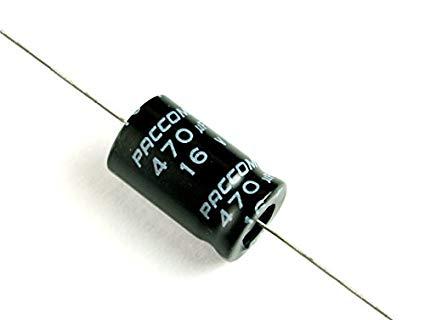Definition:
The non-polarized capacitor is one of many capacitors. According to the polarity of the capacitor, the capacitor can be divided into non-polarized capacitor and polar capacitor.
In addition to the other capacitors are non-polarized, the two electrodes of the capacitor can be arbitrarily connected in the circuit.
Effect:
non-polarized capacitors are used in pure AC circuits, and because of their small capacitance, they can also be used in high-frequency filtering. Here is an example to illustrate the application of this capacitor: This mainly introduces the RC spark suppression circuit. When receiving radio and television programs with an antenna, if the fluorescent light is turned on and the fluorescent light flickers, an irregular "click" sound will be heard in the radio or TV speakers. Many strong bright lines and bright spots on the TV screen are high-frequency clutter interference caused by electric sparks. In electronic equipment, when an inductive circuit is disconnected, similar sparks are generated between the contacts. In addition, the bribery current will soon become 0, that is, the change rate of the current is very large, so a large self-motivation potential is generated at both ends of the coil. Therefore, a large self-motivation force is generated at both ends of the coil. This electromotive force will hinder the tendency of the current to change, and its direction is consistent with the direction of the applied voltage, so the superposition of the two makes the voltage across the switch very high. When it is higher than a certain value, this "tipped" voltage change breaks down the air and forms an electric spark. This kind of electric spark will cause the contact points to be ablated and oxidized, resulting in faulty contact. Therefore, it is very important to eliminate the electric spark between the contacts. When the circuit is cut off, as long as the current of the control coil does not drop extremely, the voltage across the coil will not be too large, and no electric spark will occur, as shown in Figure 2, the RC spark suppression circuit is connected at both ends of the inductor. When the switch is suddenly turned off, i1 will charge the capacitor. A portion of the magnetic field energy in the inductor is dissipated on R and r, and a portion is converted into electric field energy in capacitor C, which causes capacitor C to re-discharge, thereby eliminating the spark.
Selection
- To choose reasonable capacitor accuracy. In most cases, the capacitor's capacity is not very high, and the nominal capacity is about the same. In the oscillation circuit, filter, delay circuit and tone circuit, you need to select the absolute value of the error within 0.3% -0.5%.
- To select capacitor according to the circuit requirements. Paper dielectric capacitors are generally used in low-frequency AC bypass circuits, and mica capacitors or secondary dielectric capacitors are generally used in high-frequency or high-voltage circuits.
- Use a capacitor with a rated voltage greater than or equal to.
- High-frequency capacitors cannot be replaced with low-frequency capacitors.
- To consider the working temperature, working range and temperature coefficient of the capacitor according to the application.
- When the nominal capacity cannot be met, a series or parallel method can be used to meet this requirement, but it should be noted that the voltage applied to the capacitor in the circuit should be less than the withstand voltage of the capacitor.
Difference from polar capacitance:
Electrode capacitors are mainly electrolytic capacitors and monolithic electrolytic capacitors. It uses sulfuric acid as an insulating medium, which can make a larger capacity into a smaller volume, and it is marked with a + symbol on it, and some with a — symbol. It is generally used for low-frequency cross-linking and bypass filtering, and the main disadvantage is that the meson loss is larger. Due to the use of special materials, the performance of monolithic electrolytic capacitors is better than ordinary electrolysis, and the frequency characteristics are better, but the capacity cannot be made too large, which can be used in accurate circuits, such as oscillation, or timing. Others are non-polarized capacitors, including paper oil-immersed capacitors and metallized capacitors, which can be made to a large capacity. Generally used for power capacitors, as well as polyester capacitors, mica capacitors, magnetic tube capacitors, ceramic capacitors, and chip capacitors for electronic circuits, which are all non-polarized capacitors. Ceramic capacitors, mica capacitors, and magnetic tube capacitors can be used in high-frequency circuits.
Difference from Non-inductive capacitor
The non-inductive capacitor is a special winding method using electrode plates, which shows a small equivalent inductance to the outside, so it is suitable for high-frequency circuits. non-polarized capacitors are actually two electrolytic capacitors connected back to back, so there is no need to consider polarity issues with ordinary electrolytic capacitors when using. For example, pillow-type correction capacitors for TVs and crossover capacitors in speakers.
The capacitor is composed of two electrode plates. In order to save space, the two electrode plates are added with an insulating material and then rolled up, and led out through two leads. This may cause a difference between the current flowing to the lead-out point of the plate and the end of the plate, because the coiled conductor is inductive, especially at high frequencies. In order to eliminate the influence of inductance, one method is to adopt positive and negative winding in different directions, so that the positive and negative inductances are canceled.
non-polarized capacitor means that it is not necessary to distinguish the polarity of the capacitor when it is used. One pole of the electrolytic capacitor is metal and the other pole is electrolyte. When the voltage application direction is reversed, the capacitor will explode. This is the difference from polar capacitors.













No Comments